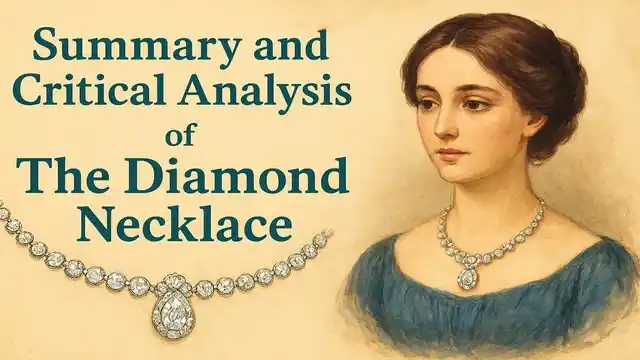Summary of the Story: “The Diamond Necklace“:
Background of the Story:
“The Diamond Necklace” by Maupassant is the story of a French girl, who suffered all her married life because of her vanity. Her vanity, however, was not without cause.
Matilde’s Unhappiness:
Born in a poor family, Matilde (that was the name of the girl) was married to a petty clerk in the Ministry of Public Instruction. She was not happy in her husband’s house, for she felt that she was born to live like a rich lady. True, she had all the qualities of a lady. She was beautiful. She had grace, charm and wit.
Her Aspirations:
Matilde dreamt of a rich, romantic life of a palatial house, foot-men, priceless silk and delicious dishes. She longed for the company of rich distinguished men.
The Fateful Invitation:
One evening Loisel returned home joyfully with an invitation to a ball (dance) party at the palace of the Ministry. He hoped that his wife would be pleased. But the invitation made her all the more sad.
Sacrifice for a Dress:
Matilde had no dress fit for the party. Her economical husband decided to give her the four hundred Francs which he had saved for buying a gun for himself.
The Need for Jewellery:
The day of the ball came near. Her new dress was also ready. Yet Matilde was sad. She had no jewel to put on. She did not like her husband’s idea of wearing natural flowers instead. She however gladly agreed with him to borrow some jewels from her rich friend, Mme. Forestier.
Borrowing the Necklace:
The next day she went to her friend, who laid all her jewellery before her to choose from. Matilde took a superb necklace of diamonds and returned home, her joy knowing no bounds.
Splendour at the Party:
The day of the ball arrived. She was victorious at the dance party. She was prettier than any other woman there. All the men stared at her, asked her name, and wanted to dance with her. She danced and drank mad with joy until 4 O’clock in the morning.
A Humble Departure:
She left at 4 O’clock in the morning with her husband, who had been sleeping in an outer room since midnight. Ashamed of the modest garments her husband had thrown on her shoulders. Matilde rapidly slipped from the palace, without waiting for a carriage. Hence they had to walk on foot for a long distance before they could engage an ugly cab.
The Shocking Loss:
All was sad and gloomy again when they reached their apartment. Matilde stood before her glass to see herself once more in all her glory. But suddenly she uttered a cry. There was no longer the necklace around her neck. Immediately search was started. In the day the loss was reported to the police and io the newspapers. A reward was offered, but all in vain.
The Crushing Debt:
At last, they had to buy a new but similar necklace for thirty-six thousand Francs, which they borrowed with a great difficulty and at high rates of interest.
Years of Drudgery:
They took ten years to pay the heavy debt. During this period, they lived a very hard and miserable life. Mme, Loisel looked old now and was hard and rough like a working woman. Now and then she only thought of that gay evening at the dance party. She wondered what her life would have been if she had not lost that necklace.
The Final Revelation:
One Sunday, when she was out for a walk, Madame Loisel saw Madame Forestier, who was still young, beautiful and charming. When Madame Forestier recognized her friend, she was surprised at the change. Matilde had undergone change since the day the necklace was returned. Matilde told her friend all about the loss of the necklace and its replacement. Mme. Forestier was strongly moved and disclosed that the necklace was an artificial one costing only five hundred Francs.
Critical Appreciation of “The Diamond Necklace“:
General Introduction:
“The Diamond Necklace” is one of the best short stories of Guy de Maupassant. One who begins this story must read it all. It is so interesting. And at the end one realizes that it is also instructive.
Central Theme:
The theme of the story is woman’s too much love of display of her personal charms and her consequent suffering.
Strength of the Plot:
The plot of the story “The Diamond Necklace” is very well constructed, and it is so important that we may call the story a story of plot. The opening of the story describes the main characters, their social status and their individual natures. The story develops with the receipt of the invitation to the party. The preparations for the party-the buying of a new dress, the borrowing of the diamond necklace-the party itself, the loss of the necklace, the borrowing of money to replace it, and the paying of ‘the dreadful debt”, all fill the main body of the story, and do so very effectively. And the end of the story is marvellous. The diamond necklace was only an artificial one. What a pleasant shock!
Character Portrayal:
There are only three characters. Of them only two Mr. and Mme. Loisel are those who matter. They are very well drawn. They serve as a foil to each other by their contrary natures. They are life-like. The central figure is, however, Mme. Loisel. The writer seems to have spent all his art in making her an unforgettable character.
Use of Dialogue:
The dialogues take place between Mr. and Mme. Loisel and between Mme. Loisel and Forestier. They are desirably short, natural and effective. For example, take this one.
She turned madly towards him, “I have-I have-I’ve lost Mme. Forestier’s necklace.”
He sprang up, distracted, “What! –How? –Impossible!”
Narration and Description:
A short story writer has to be a good narrator. Maupassant knows his business well. He tells this story in the historical method which suits it well. A story writer has also to describe things sometimes. Maupassant shows his skill here as well. His description, for example, of the silent ante-chambers, is a masterpiece.
Style and Language:
The language of the story is easy, smooth and delightful. The style is graceful and charming. There is nothing vague about the writer. He is accurate and precise. And, as Conrad says, he is never dull.
Appropriateness of the Title:
The title of the story “The Diamond Necklace” is most appropriate. The whole story is about the diamond necklace, its borrowing, its loss, its discovery of being artificial.
The Moral Lesson:
The story “The Diamond Necklace” throws light on woman’s character. In the case of women family and birth do not count. Their beauty, grace, and charm make them feel to be equal of the greatest ladies. The story is also a lesson against vanity of women.
Thus, the story “The Diamond Necklace” is not allowed to become pathetic, though the situation demanded it. Chance is made to serve for fate, but not improbably. Everything in the story is in its right place.




